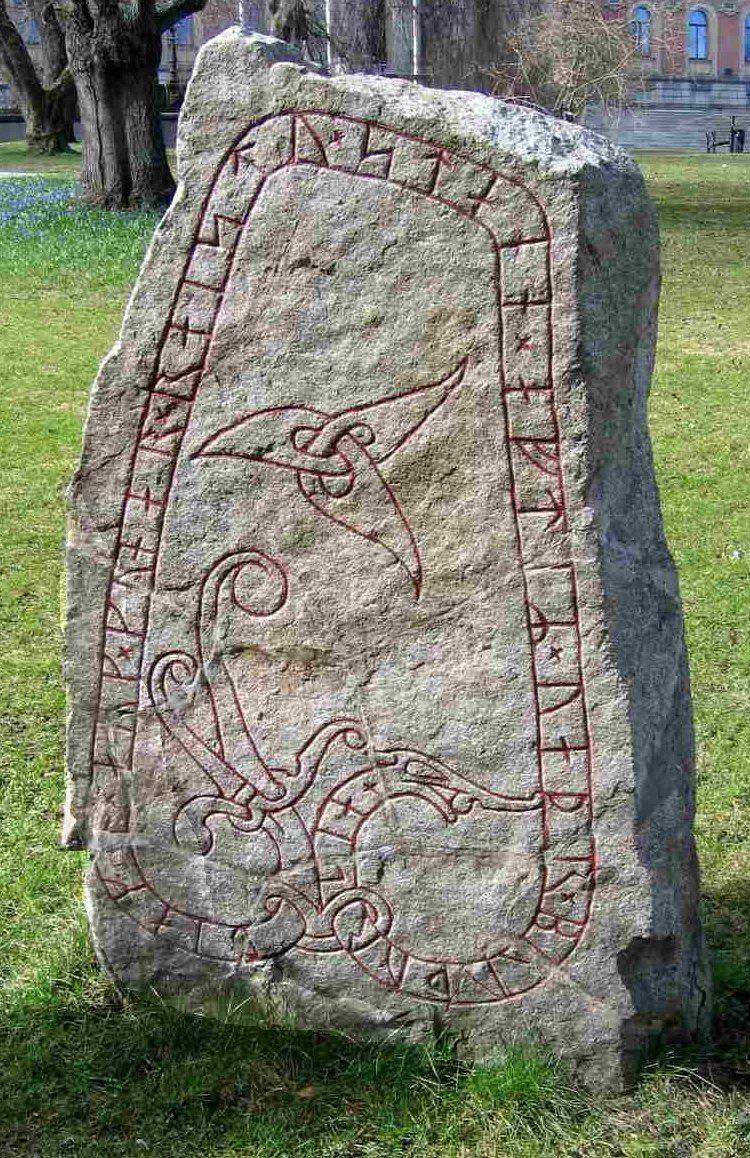 | ||
The Funbo runestones constitute a group of four runestones originally from Funbo in the province of Uppland, Sweden, which were raised by members of the same family during the eleventh century.
Contents
The following presentations show the runic script transliterated into Latin script, together with transcriptions into the Old West Norse and Old East Norse dialects of Old Norse and translations into English. The runestones are listed in order of their Rundata catalog listing, chronologically U 999 is the oldest inscription and is followed by U 990 and then the two stones U 937 and U 991.
U 937
The runestone designated as U 937 in the Rundata catalog was found in Uppsala in 1875 in the walls of a Franciscan monastery between the streets of St. Persgatan and Klostergatan, and is currently located at a park in Uppsala University. The fact that its inscription mentions names from the same family as the runestones of Funbo, shows that it was formerly part of the same group. Like many other runestones, it had been used as construction material at a time when the historical significance of the stones was not understood. It is considered to be a good example of runestone style Pr3, which is also known as the Urnes style. This runestone style is characterized by slim and stylized animals that are interwoven into tight patterns. The animals heads are typically seen in profile with slender almond-shaped eyes and upwardly curled appendages on the noses and the necks. On this stone the runic text lies within a serpent that circles a triquetra, which would have been considered a high status motif.
Because the runic text of runestones U 937 and U 991 have the same message, it has been suggested that they were once at the same site and formed a coupled memorial to the deceased brother Veðr. They are considered to be the most recent of the four Funbo inscriptions and, although unsigned, are considered to be the work of the runemaster Fot. He is known for his Urnes style inscriptions and for the consistency of his use of the punctuation mark × between words, as shown in the runic text of this runestone.
Inscription
Transliteration:
× þiak(n) × auk × kunar × raistu × stana × aftiʀ × uaþr × bruþur sin ×Old West Norse transcription:
Þegn ok Gunnarr reistu steina eptir Veðr, bróður sinn.Old East Norse transcription:
Þiagn ok Gunnarr ræistu stæina æftiʀ Veðr, broður sinn.English translation:
Thane and Gunnar raised this stone after Veðr, their brother.U 990
Runestone U 990 has its runic text within a serpent that circles a central Christian cross. It remains in its original location in Funbo. It is composed of granite and is 1.5 meters in height. This stone is classified as being carved in runestone style Fp, which is characterized by runic bands that end with animal heads when seen from above.
Inscription
Transliteration:
uaþr + auk × þakn × auk × kunar + raistu × stain + þana × at × haursa × foþur sin + kuþ hialbi ot hans ×Old West Norse transcription:
Veðr ok Þegn ok Gunnarr reistu stein þenna at Haursa, fôður sinn. Guð hjalpi ônd hans.Old East Norse transcription:
Veðr ok Þegn ok Gunnarr ræistu stæin þenna at Haursa, faður sinn. Guð hialpi and hans.English translation:
Veðr and Thane and Gunnar raised this stone after Haursi, their father. God help his soul.U 991
Runestone U 991, which is composed of granite and is 1.5 meters in height, consists of runic text within a serpent that circles a central beast. Although having different imagery, it contains the same message in its inscription as U 937. Because they have the same message, it has been suggested that they once formed part of a coupled memorial at the same site to the deceased brother Veðr. These are considered to be the most recent of the four Funbo inscriptions and, although unsigned, are attributed to the runemaster Fot. U 991 is classified as being carved in either runestone style Pr3 or Pr4.
U 999
Runestone U 999 has text within a band that ends in a serpent head and was raised by Haursi and his brother after their father. This granite stone is 1.65 meters in height and is considered to have the oldest inscription of the four runestones from Funbo. It is classified as being carved in runestone style Fp.
Inscription
Transliteration:
haursi : auk : kitil : raistu : aftir : þekn : faþur : sin : staina : þisa : at : bunta : kuþan : o : funumOld West Norse transcription:
Haursi ok Ketill reistu eptir Þegn, fôður sinn, steina þessa, at bónda góðan á Funnum/Fúnum.Old East Norse transcription:
Haursi ok Kætill ræistu æftiʀ Þegn, faður sinn, stæina þessa, at bonda goðan a Funnum/Funum.English translation:
Haursi and Ketill raised these stones in memory of Þegn , their father; in memory of the good husbandman of Funnir/Fúnir.